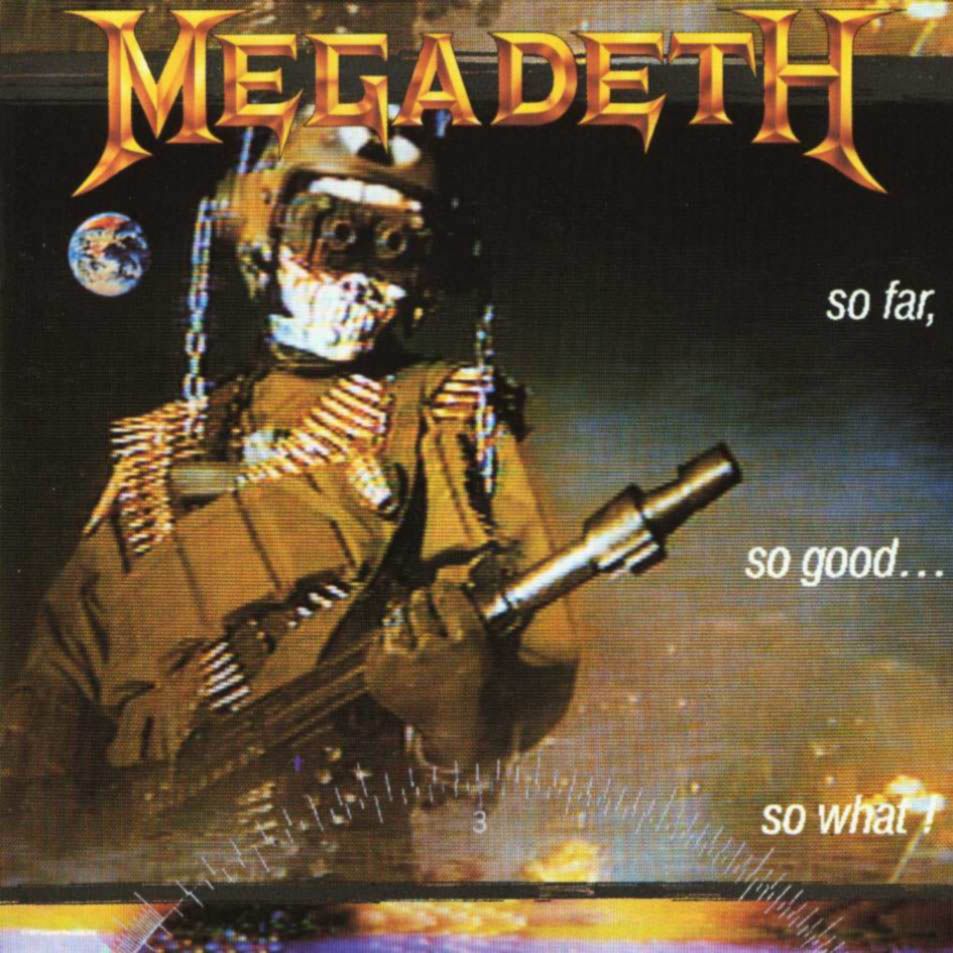Megadeth: Revisiting So Far, So Good… So What!
So Far, So Good… So What! is the forgotten Megadeth album. Largely forsaken in concert, the 1988 classic has gotten lost in a vast discography. Perhaps it simply had the misfortune of being sandwiched between Peace Sells and Rust in Peace. Despite the fall from grace, So Far, So Good… So What! captures Megadeth at the height of their 80’s glory.

So Far, So Good… So What! was an undeniable success. It sold 400,000 copies in its first month of release and eventually went platinum. Despite receiving zero commercial airplay, the album cracked the top 30 on the Billboard 200. Megadeth was no longer an underground band!

The original Megadeth line-up disintegrated when Gar Samuelson and Chris Poland were fired in the summer of 1987. Drum tech Chuck Behler promptly joined the band but filling the guitar slot didn’t come easy. Initially, Jay Reynolds of Malice was hired to replace Chris Poland.

Instead of rehearsing with their new guitarist, they bonded through drug use. When Megadeth finally sat down to write and record, it quickly became apparent that Reynolds was in over his head. Studio time had been booked and paid for, now their new guitarist was asking to have his guitar teacher play the solos.

That guitar teacher was Jeff Young. Although Young was a proficient guitarist, he was far removed from the thrash scene. Despite harboring reservations about Young’s non-metal background, Mustaine fired Reynolds and hired his guitar teacher. The second Megadeth line-up was complete.

Short on time, a brand new line-up began recording the third Megadeth album with producer Paul Lani. Known for working with Rod Stewart, Lani clashed with the volatile Dave Mustaine and was ultimately fired.

Michael Wagener was brought in to mix the album. His credentials were impressive. Not only did Wagener work with mainstream metal acts like Accept and Motley Crue, he had mixed Metallica’s Master of Puppets.
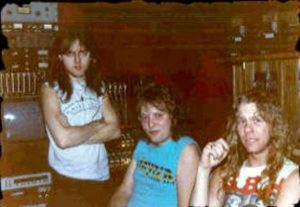
Mustaine was STILL not pleased with the results. He complained of excessive reverb that gave the record a muddy sound. In 2004, So Far, So Good… So What! was remixed and remastered. Many prefer the original mix and younger fans are encouraged to seek out vintage pressings.
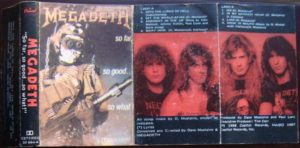
Any doubts about the new line-up were put to rest during the album’s opening track. “Into the Lungs of Hell” is an instrumental that allowed new guitarist Jeff Young to shred along with Mustaine. The addition of horns, winds, and percussion demonstrated that Megadeth were willing to experiment while still providing raw brutality.
“Into the Lungs of Hell” transitioned seamlessly into “Set the World Afire.” Regarding enhanced production, the track began by sampling an old 1940’s song titled “I Don’t Want to Set the World on Fire.” The old-time ditty was interrupted by the sound of a nuclear explosion followed by a full-on thrash fest.
“Set the World Afire” has the distinction of being the oldest Megadeth song. It dates back to Mustaine’s famous termination from Metallica. On the long bus ride to L.A. from New York, Dave found a discarded political pamphlet discussing nuclear proliferation. One line, “the arsenal of Megadeath can’t be rid no matter what the peace treaties come to,” brought inspiration.
On the back of a cupcake wrapper, Mustaine penned his first post-Metallica song. Originally called “Megadeth,” Mustaine soon realized the title was better suited as a band name. The initial song idea fell dormant. Now, for album number three, that first Megadeth song was reborn as “Set the World Afire.”
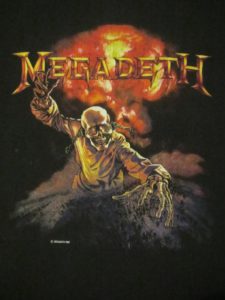
The first two Megadeth albums featured cover songs and So Far, So Good… So What! carried on that tradition. Mustaine knew from the start he wanted to record a Sex Pistols song. His original vision was “Problems” but was later convinced that “Anarchy in the UK” was a better choice. The latter song would be instantly recognizable and serve the band well from a marketing standpoint. A promotional video was filmed and “Anarchy in the UK” found airplay on Headbangers Ball.
“Anarchy in the UK” actually had a real Sex Pistol playing in the studio. Steve Jones just happened to be living in Southern California and accepted Dave’s invitation to play on the record. Despite having a broken arm, Jones drove in on his motorcycle, jokingly requested “a hundred dollars and some suction,” then laid down guitar tracks.
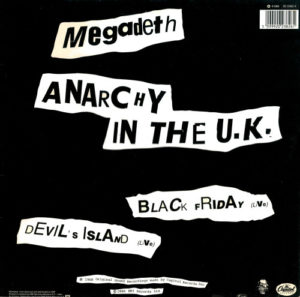
Side one is closed out with “Mary Jane.” The track tells the story of Mary Jane Twillinger. According to legend, this young girl was a witch that was buried alive by her father. If anyone dared violate her grave, they would meet an untimely death.
Although no video was filmed for “Mary Jane,” the song was released as a single. The occasion called for a new rendering of mascot Vic Rattlehead. It was common to see “Mary Jane” t-shirts and patches throughout the late eighties.

Side two opens by glorifying reckless driving with “502.” It was infinitely amusing to hear “pull over shithead, this is the cops!” Fast cars, “cigarettes and burgers, caffeine and alcohol,” fuel this classic speed metal track.
After learning of Cliff Burton’s death, Dave Mustaine scored heroin, cried, then picked up his guitar and wrote “In My Darkest Hour” in one sitting. While the music was directly inspired by the emotion felt by Cliff’s passing, the lyrics deal with Mustaine’s relationship struggles with long-time girlfriend Diana.

Director Penelope Spheeris had previously directed the “Wake Up Dead” video. Now, she filmed “In My Darkest Hour” for her documentary, The Decline of Western Civilization Part II: The Metal Years.
“Liar” is a vicious rant directed towards former guitarist Chris Poland. Clearly still angry, Dave Mustaine unloaded his hatred in a public verbal lashing.
“Liar” was also released as a single. Like “Mary Jane,” there was no promotional video. “Liar” contained no intriguing artwork or b-sides. Very few copies remain in circulation.

The P.M.R.C. were at the height of their crusade in 1988. Heavy metal was a key target in their witch-hunt against explicit artists. Megadeth wrote a rallying cry for metalheads opposed to censorship. Essentially an anthem for free speech, “Hook in Mouth” was a worthy closer to a classic metal album.
The line-up that produced So Far, So Good… So What! lasted less than a year. Like Gar Samuelson before him, Chris Behler’s drug use created friction that ultimately led to his termination. In an ironic twist of fate, Behler was replaced by his drum tech.

Jeff Young was fired shortly thereafter. There had been persistent personality clashes throughout Young’s tenure in Megadeth. The final straw came when Jeff made a pass at Mustaine’s fiancée. Young was promptly fired and a short era in Megadeth history ended.

Megadeth essentially abandoned their masterpiece. Only “In My Darkest Hour” remained a live staple. Was this an extension of Mustaine’s dislike of the album’s production? Perhaps there was a desire to minimize the short-lived line-up’s contribution. By ignoring a platinum-selling album, the memory of So Far, So Good… So What! has faded as the Megadeth discography grew.
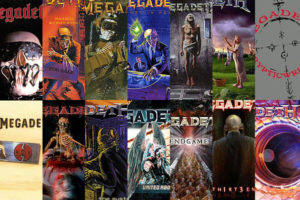
Thirty years have passed since the release of So Far, So Good… So What! The songs hold up quite well and are a product of thrash metal’s glory years. The third Megadeth entry may not hold the esteem of Peace Sells or Rust in Peace but it remains a classic slab of vintage thrash.

